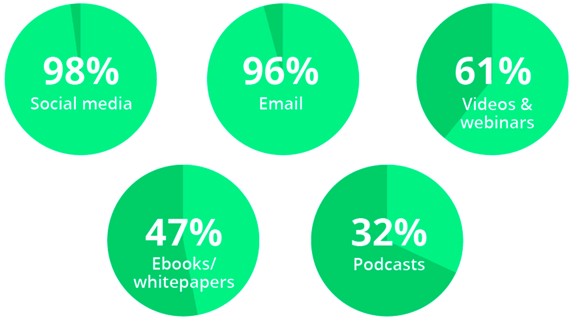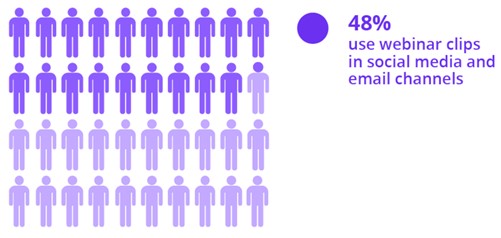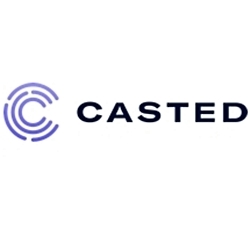Video and podcasting are not new marketing tools. Video has populated content plans for years, and podcasting shows up more every year. But one big takeaway from Casted's The State of the Content Marketer Report is that video and podcast content still have room to grow.
When done well, video is the most effective content type you for reaching your audience. Surprisingly, we found that although virtually everybody does social media (98%), emails and newsletters (96%), and blog posts (93%), only a little over half of content marketers are consistently putting out videos and webinars (61% for each).

For that hesitant 39% out there, here's why video can be so powerful:
- A full 86% of people want more video from brands in general, and 54% specifically want marketers to produce more video content.
- On average, audiences watch 16 hours of online video a week—up 52% in the last two years.
However, as Casted discovered in its recent study, only a little over half of brands use video as part of their marketing strategy, and only one-third are producing podcasts. So, what gives?
Customers, prospects, and consumers want more video, and over the last few years podcasting has continued to grow as an inexpensive content marketing channel.
That presents a huge opportunity to deliver both kinds of content to your audience, and it's good for your team, as well. Video and podcasting—both audio and video—offer some of the most creative content a marketer can produce. It's also most effective at engaging your audience. Why aren't 100% of brands producing such content?
Casted conducted a survey to figure that out, and we analyzed responses from 100+ B2B content marketers in the US. The result is The State of the Content Marketer Report, for which a lot of questions were asked about the effectiveness of content in different formats and channels, how those channels are changing, how content marketers are adapting, and how brands have (or have not) adopted video and podcasting content.
Why Video Has to Be a Big Part of Your Content Marketing Strategy
It's no secret that people find video more engaging than text and images. A full 66% of people said they prefer watching a product video over reading a blog post on the same thing, according to a Wyzowl study.
Why? Well, video is easier to consume and more convenient than a blog post. Plus, the medium allows brands to use conversations, music, and rich imagery to evoke an emotional response from viewers. In advertising, emotive video campaigns outperform those that don't use video—in some cases with a success rate as high as 31%.
1. The pandemic accelerated the demand for video
As the Internet developed, people had to scroll through mountains of text, and although we managed to learn things here and there, humans have always needed easier ways to learn about subjects and research purchases. That's where video—and the tech that makes it conveniently work wherever you are in the world—changed everything.
For example, video is still growing as one of the most preferred content formats by audiences:
- This year, online videos will comprise more than 82% of all consumer Internet traffic—15X growth since 2017, Cisco predicts.
- In 2019, just 46% (less than half) of brands were consistently producing webinars, but in 2020, webinar use rose to 62%.
- By June 2020, there had been an 800% increase in global watch time of ad-supported and purchased feature-length movies over the previous year.
- That consumption increase is further illustrated by 68% of consumers' saying the pandemic has affected the amount of video content they watch online: The overwhelming majority (96%) say they're spending more time viewing video.
- When they need to learn about new products or services, 68% of consumers prefer video over blog posts, infographics, e-books, and presentations.
- Viewers retain 95% of the content when they watch a video, compared with 10% when they read text.
- A video ad persuaded 79% of people to buy a product, they reported.
The shift toward video sends a clear message to content marketers that audiences want video, particularly four main types: product demos, explainer videos, how-tos, and testimonials. For example, 94% of shoppers said they watch explainer videos to learn more about a product or service, and 84% reported that videos influence them to purchase.
2. Brands that do video have higher ROI
As determined by Casted's report, content marketers are responsible for pipeline and conversion. So, with the bottom line in mind...
- A full 87% of marketers creating video (up from 33% in 2015) think video gives them positive ROI.
- Blog posts with embedded video garner 3X as many inbound links as posts with no video.
- When you include video on a landing page, you can increase conversions by 80% or more.
- Marketers who include video in their campaigns have 34% higher conversion rates.
3. There is rising demand for embedded video clips
Another takeaway from the report is that most brands are not amplifying their webinars and video across multiple channels. Video is easy to promote when you can cut it up into nice bite-size clips and embed in other formats. As for or webinars, everyone we surveyed publishes them on their own websites, but only 48%—less than half—are using clips from webinars in their social media and email channels.

Content marketers want tools to amplify and promote their video content. In the report, 87% are already embedding audio and video content in their social media, but far fewer are including video clips in blog posts (31%) or email/newsletters (11%).
How Podcasting Should Fit Within Your Content Marketing
People gravitate toward expert conversations when they want to learn more about a topic, industry, or product. Podcasts give brands a whole new channel for disseminating content; and, best of all, podcast listeners consume more of each episode than they do of a blog post or an e-book.
B2C and B2B podcasts are steadily gaining listeners, yet...
- Only 32% of content marketers say podcast content is an effective channel, The State of the Content Marketer Report found.
- Despite podcasting's low barriers to entry, most brands are not investing in podcasts as a content marketing channel (only 32% reported putting out podcasts—fewer than all other content formats, including whitepapers and webinars).
That spotlights an enormous opportunity for brands to develop the channel. The right tools and mindset can enable you to create well-executed, branded podcasts that...
- Expand audience reach
- Lend credibility to your brand
- Create top-of-mind recall
- Help drive deeper customer engagement
- Build trust
How Podcasting Influences Brand Awareness, Audience Reach, and, Yes, Even ROI
Podcasts are one of the most effective ways to achieve brand awareness, for a few reasons:
- People want to hear expert conversations.
- People turn to podcasts to learn new things.
- Content marketers can repurpose podcast content, cut it up into clips, and use it to promote the podcast through other channels, such as social, blogs, and email.
Yes, the path to purchase from consuming podcasts can be long and hard to plot (there's a great demand for better analytic tools). But more and more, content marketers are noticing their podcast content converting.
Although video revenue attribution is easier to track, don't dismiss how much a podcast can contribute to your bottom line. According to stats cited by Buzzsprout...
- Podcast fans are highly engaged: a full 80% say they listen to all or almost all of every episode they start.
- Some 69% of podcast listeners say that podcast ads increase their awareness of brands, products, and services.
- Some 60% of podcast listeners say they have purchased a product because of a podcast ad.
- Podcast fans are super loyal: 72% say they have purchased something from a sponsored ad on any podcast they've listened to for four or more years
- A full 81% of those who haven't purchased because of an ad say they still pay more attention to podcast ads than they do to the equivalents in TV, radio, digital, and social media.
The Bottom Line
Because the effectiveness of various kinds of content changes along with audience preferences, content marketers need tools to keep pace, and they need buy-in from leadership to constantly improve process and strategy to better serve their audiences.
Considering how engaging video is and how well it brings in leads and revenue, it's surprising that it's still not something every brand does.
On the other hand, reluctance to get into podcasting can be chalked up to a fear of the unknown. But if you're listening to your audience's feedback, then you know what they want—they prefer to listen to experts discuss a topic rather than to read a blog post about it.
If you want more insights into the challenges B2B content marketers face and the solutions they need to create and amplify excellent content, check out the full report.




